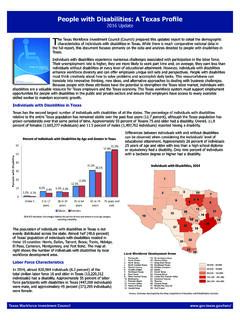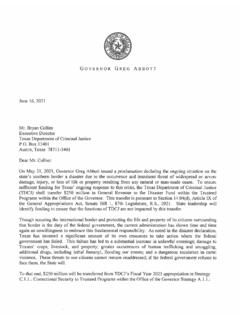Transcription of Texas renewable energy
1 Texas renewable energy The Texas renewable energy Industry 2014. Office of the Governor | Economic Development & Tourism Contents Overview . 1. Wind energy .. 2. Solar .. 20. Biofuels & Biomass.. 25. Key Terms This report references a few technical terms to describe energy and power. Power is the rate at which electricity flows. Power is often measured in gigawatts (GW), which are equivalent to one thousand megawatts (MW). One MW is equal to 1,000 kilowatts (kW). One MW of electricity is enough to power roughly 300 homes at a typical rate of usage. A single medium-sized wind turbine operating at full capaci- ty can, on average, generate one MW. energy is the total amount of electricity consumed over a period of time. energy is often measured in megawatt-hours (MWh), which are equivalent to 1,000 kilowatt-hours (kWh).
2 British thermal units (BTU) are also used to measure energy . One MWh is equal to million BTU. Kilowatt-hours are the most commonly used billing units for electricity in the United States ( ). A household appliance, such as an air conditioner or microwave, rated at 1 kW operating for one hour uses 1 kWh. Texas renewable energy Headlines Texas ranks No. 1 in the nation for wind energy capacity and biodiesel production See Pages 13 & 26. If Texas were a country, it would Southern Power Company's rank No. 6 Nacogdoches Generating globally for Facility in Sacul, Texas , is the installed wind largest biomass power plant in energy capacity the nation See Page 12 See Page 27. Texas ranks #2 RBF's Port Neches Texas nationally for Facility, located in A&M's employment in the the Houston area, Center for Solar renewable energy is the nation's energy will be the industry largest biodiesel world's largest production plant solar PV R&D.
3 Facility when complete See Page 10 See Page 26 See Page 22. CPS energy is working on a Royal Dutch Shell relaunches landmark 400 MW solar its Shell Technology Center in project in San Antonio that will Houston with a be the nation's largest when focus on biomass- complete sourced biofuels See Page 21 See Page 27. The Texas energy Industry According to the energy Information Admin- istration (EIA), Texas is the leading state for overall energy production and consumption. The state is also the leading producer, importer, and refiner of oil and gas products. Texas ranks No. Innovation in the natural gas industry 1 in the nation has further solidified Texas ' role as for wind energy Brazos Wind Farm, West Texas the nation's energy leader over the capacity and past few years.
4 The energy industry F or over a century, Texas has been an interna- biodiesel is an important part of the diverse tional leader in the oil and gas industry. In production and growing Texas economy. recent years, the state has built upon its energy experience and trained workforce to take the lead in renewable energy is a vital component of Texas ' all- renewable energy production and services. As a result, of-the-above strategy for energy independence and Texas has become the top state in wind generation leadership. Reliance on a single source of energy can capacity and biodiesel production. threaten energy security and heighten price volatility. energy diversification across different sectors (fossil The Lone Star State's energy potential is among the fuel, nuclear, and renewable ) and geographies (high largest in the nation, with abundant wind, solar, and plains wind and coastal wind, for example) can help biomass resources found across the state's geograph- make Texas energy more robust and flexible.
5 A. ically diverse regions . diverse energy portfolio can also better respond to Ernst & Young ranked Texas No. 3 in the nation in its changing economic and geopolitical conditions. Renewables Attractiveness Indices in August 2013. A variety of factors are used to determine a Texas renewable energy Consumption 2011. state's ranking, and in Texas ' case, relied primarily on wind and solar resources, followed by biomass and lastly geothermal resources. The state has developed a strong foundation in the growing renewable energy industry. According to Texas Workforce Commission data, over 102,000. Texans are directly employed in renewable energy sectors, and thousands more work in industries closely tied to the renewable energy industry. Texas ' business climate encourages renewable technology innovation and commercialization, and the state is home to leading research institutions working in renewable energy industry areas.
6 Source: energy Information Administration 1. OVERVIEW. Key Texas Texas Attracts renewable energy renewable energy Rankings Investment from around the World No. 1 in wind energy capacity Selected foreign companies with No. 1 in wind energy -related manufacturing renewable energy operations in Texas : No. 1 in wind industry employment China No. 2 in total renewable energy employment Growatt: Houston No. 1 in biodiesel production France No. 1 in solar potential Alstom: Amarillo, Lubbock, etc. No. 6 in solar energy industry employment EDF Energies Nouvelles: Statewide (wind farms). No. 4 for clean energy -related patents Germany : Austin, statewide (wind farms). Kako new energy GmbH: Top 5 Texas -Based Companies with San Antonio renewable energy Operations Italy Enel : Hermleigh Semiconductor/PV.
7 Products HQ: Dallas The Netherlands Royal Dutch Shell: Houston, Semiconductors/ statewide (wind farms). inverters HQ: Austin South Korea OCI Solar Power: San Antonio 100% renewable Samsung: Austin energy utility HQ: Austin Spain Gamesa: Statewide (wind farms). Ethanol production Energia ERCAM: San Antonio HQ: Plano Iberdrola: Statewide (wind farms). Utility operating United Kingdom landfill gas sites HQ: Houston BP: Houston, statewide (wind farms). RES Ltd: Statewide (wind farms). 2. OVERVIEW. renewable energy in Texas and solar deployment has the potential to be similarly meteoric over the current decade. According to While renewable energy has a relatively small impact ERCOT, statewide solar generation increased 265%. on energy consumption in Texas , its share is growing from 2011 to 2012 alone, from rapidly.
8 renewable sources accounted for of all 36,580 MWh to 133,642 MWh. Biomass and energy consumed in Texas in 2011, according to the Texas currently ranks No. 6 biofuels account EIA. This ratio has increased substantially over the nationally in installed solar photo- for 36% of Texas '. past decade as renewable energy sources have voltaic PV capacity. renewable energy expanded, while total statewide energy consumption The strength of the Texas biomass consumption has remained steady over the past 15. and biofuels industr y lies in the Wind energy years. state's natural resources, skilled workforce, and accounts for Wind gener ation in the state was existing petroleum-based infrastructure. More bio- 76% of Texas ' twelve times larger in 2011 than 2002, diesel is made in Texas than in any other state, and renewable and wind's share of the Texas Inter- biomass facilities harvest usable energy from landfills, energy connection Region's electric power wastewater, and byproducts of forestry, livestock, and consumption generation was at the end of agriculture across the state.
9 Biomass and biofuels December 2013. Wind energy now account for 36% of Texas ' renewable energy con- comprises over three quarters of sumption. Texas ' renewable energy usage, followed by biofuels Texas also has small amounts of renewable energy and biomass (see chart on page 1). resources from geothermal and hydroelectricity. The 2000s was the decade wind accelerated in Texas , Altogether, these account for less than 3% of the state's total renewable energy portfolio. Texas renewable energy Growth 1985-2011. 400. energy Consumption 300. (Trillion BTU). 200. All renewable 100. Wind 0. 1985 1990 1995 2000 2005 2010. Source: energy Information Administration 3. OVERVIEW. The Texas Electric Grid In the continental United States, the electricity system consists of three regions , the Eastern Interconnection, the Western Interconnection, and the Texas Intercon- nection.
10 The latter, operated by the Electric Reliability Council of Texas (ERCOT), is separate Texas is the from the rest of the nation, making only state in Texas the only mainland state with its the lower 48 own grid. As a result, the utilities within ERCOT are exempt from most federal with its own SPP: Southwest Power Pool regulation. SERC: Southeast Electric Reliability Council power grid WECC: Western Electricity Coordinating Source: PUC. Council ERCOT is a membership-based, non- profit corporation whose members include electric utilities, generators, and transmission providers. The ERCOT's Texas Interconnection Region covers 75%. organization works to ensure generation, transmission, of the state's landmass and 85% of the electrical load and frequency regulation services are available to (see map above).











